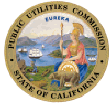 California Public Utilities Commission
California Public Utilities Commission
505 Van Ness Ave., San Francisco
_________________________________________________________________________________
FOR IMMEDIATE RELEASE PRESS RELEASE Media Contact: Terrie Prosper, 415.703.1366, news@cpuc.ca.gov Docket #: Res T-17187 and Res T-17195
CPUC APPROVES $8 MILLION TO HELP BRING
BROADBAND TO UNSERVED AREAS
SAN FRANCISCO, February 20, 2009 - The California Public Utilities Commission (CPUC) today approved funding for five projects that will bring high-speed, Internet broadband service for the first time to thousands of households in unserved areas, helping to bridge the "digital divide" in the state.
The projects, funded from the California Advanced Services Fund (CASF), total $8,047,552 and represent 40 percent of the total project costs for broadband infrastructure for the five areas, which are: Alta/Blue Canyon (Nevada/Placer Counties), Carmel Valley (Monterey County), Comptche (Mendocino County), and Warner Springs (San Diego County), and 11 communities along Highway 299 in Humboldt, Trinity, and Shasta counties.
On December 20, 2007, the CPUC established the two-year CASF to provide 40 percent matching infrastructure grants to broadband providers willing to put up the matching 60 percent of funds and to serve the nearly 2,000 California communities that are currently unserved and underserved by broadband.
The CPUC has designated $100 million in the CASF to provide these 40 percent matching grants. Of that $100 million, $8,420,528 in broadband infrastructure grants have been approved so far.
"The policies we adopted in late 2007 to make California a national leader in broadband deployment become very real when projects like these are brought before us," said CPUC Commissioner Rachelle Chong, a member of the state's Broadband Task Force. "After 14 years of efforts the community of Comptche, including the children at Comptche Elementary School, will finally have broadband Internet access."
"The economic stimulus package signed into law this week by President Obama showcases a number of broadband initiatives that are consistent with our actions, such as the statewide broadband mapping from the Broadband Task Force, funding for broadband infrastructure to provide access to unserved and underserved communities similar to our CASF program, and telehealth projects similar to our ambitious California Telehealth Network," said CPUC President Michael R. Peevey.
Of the projects approved today, the Highway 299 Broadband Network by Broadband Associates, International, Inc., will connect fiber optic lines to towers that will transmit wireless signals along the 150-mile route through portions of Humboldt, Trinity, and Shasta Counties covering an area of about 1,000 square miles. The 11 communities of Glendale/Blue Lake, Korbel, Willow Creek, Salyer, Big Bar/Big Flat/Del Loma, Junction City, Weaverville, Douglas City, Lewiston, French Gulch, and Burnt Ranch/Hawkins Bar/Trinity Village between the cities of Eureka and Redding will receive high-speed Internet broadband service for the first time. Broadband Associates' matching grant is for $7,830,720.
AT&T's projects will provide broadband internet service for the first time to 482 unserved households covering 30.29 square miles of territory in four unserved areas: Alta/Blue Canyon (Nevada/Placer Counties), Carmel Valley (Monterey County), Comptche (Mendocino County), and Warner Springs (San Diego County). AT&T will provide high-speed, stand alone, Internet access service, where technically feasible, using existing DSL technology and where it has wireline facilities. AT&T's projects will receive matching grants from CASF totaling $216,832.
The applications approved today are the second set to be approved among the 23 applications received for CASF funding for unserved areas. The first set of projects was approved on November 21, 2008. Applications from broadband providers are still being accepted for both unserved and underserved areas.
For more information the Governor's Broadband Taskforce, please visit www.calink.ca.gov/pdf/CBTF_FINAL_Report.pdf.
For more information on communications issues, please visit www.CalPhoneInfo.com.
For more information on the CPUC, please visit www.cpuc.ca.gov.
###
